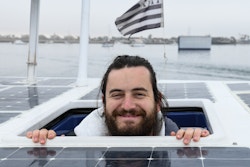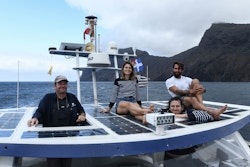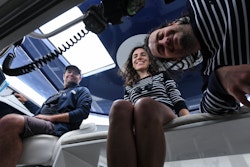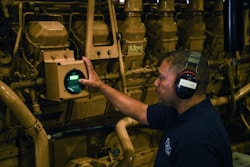Jamestown, Saint Helena
After seven days of sailing from Walvis Bay in Namibia, our laboratory vessel arrived on the mysterious island of Saint Helena.
Coming from: Walvis Bay, Namibia
Weather conditions: Cloudy
Time of arrival: 4:30 PM
Travelled distance: 1 279,7 nautical miles

School visits on board
A rough crossing
When leaving Namibia, our crew was warned: be prepared for a bumpy crossing!

Energy Observer leaving Namibia
When leaving Walvis Bay, Jean-Baptiste, our captain, gathered the crew for a short weather brief to bring everyone up to speed on the prospects for this first half of the transatlantic crossing.
Favorable weather conditions
“Crosswinds, downwinds, currents in the right direction, and sunshine that's a little shy yet enough to recharge our batteries: it feels good to be sailing while having the elements with us!”

Sunset on board Energy Observer
Even if seasickness got the better of some, the slightly rough conditions enabled our catamaran to reach its destination ahead of schedule!

Energy Observer leaving Walvis Bay
The propulsion wings did most of the sailing, stealing the show from our engines, which only ran for 55 hours over the seven days of sailing.
As for the hydrogen, our reserves have barely been tapped and will enable us to cover the second half of the transatlantic.
“The vessel did very well! We covered over 1279.7 nautical miles in 7 days and 9 hours, with an average speed of 7.23 knots. That's pretty good! We can be happy!”

Energy Observer leaving Walvis Bay
Intermediate stage of our transatlantic journey
St. Helena marks the 82nd stopover of our Odyssey, and is halfway between Namibia and Brazil.
The crew arrived under not-so-welcoming skies and a drizzle. Yet, with a guaranteed mystery atmosphere!
“It's a once-in-a-lifetime experience to arrive on the island of Saint Helena by sea! It's one of the most isolated islands in the world. Yet, it's a landmark in French and maritime history.”
A busy schedule of visits
St Helena has a population of around 4,000, according to the latest statistics (source: The Sentinel St Helena), and the interest shown by the locals in our laboratory vessel was evident from the moment we arrived! More than 150 people came on board to discover our onboard technologies and their potential, including institutions and schoolchildren.
Filming on the island's energy future
Our onboard reporter Agathe Roullin left the vessel for a few hours to meet the team at Connect St Helena, which manages the production and distribution of electricity on the island via several sites: a solar power plant, a wind farm, and a thermal power plant.
The island is still heavily dependent on fossil fuels (imported oil accounts for 81% of electricity consumption) and is looking to increase the share of renewable energies to 80% of its energy mix by 2027-2028.
Find out more in our dedicated topic on our YouTube channel.
Once an essential stopover on the route to India, the island has been less frequented since the inauguration of the Suez Dam in 1869. Our crew will spend a few days in what was once known as the "Inn of the Atlantic" before continuing westwards.























